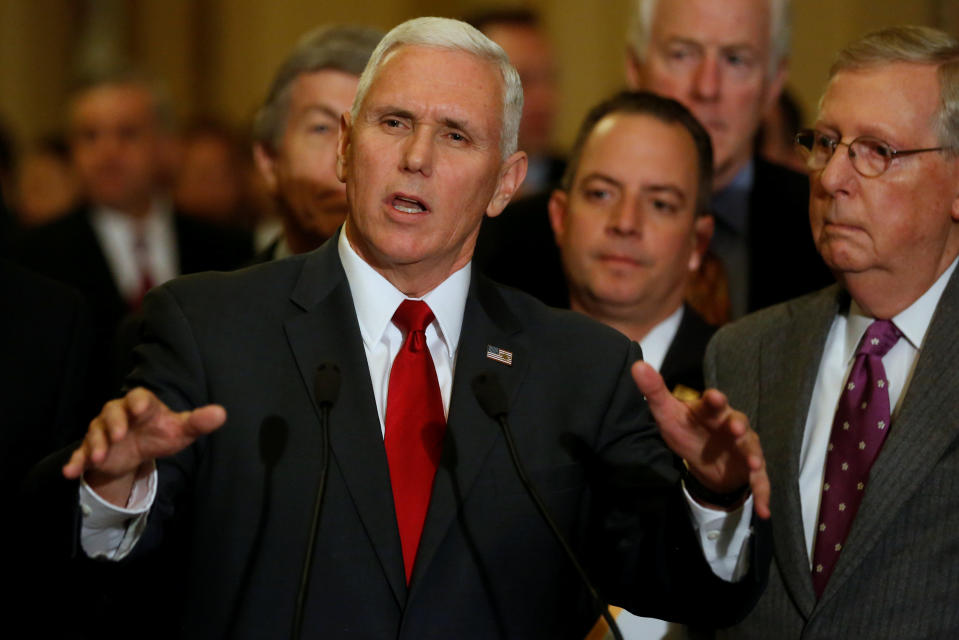Bipartisan Committee: Killing Obamacare would cost $350 billion

A new report from the Committee for a Responsible Federal Budget, a non-partisan public policy think tank, warns that a full repeal of the Affordable Care Act would cost up to $350 billion over the next 10 years.
On Tuesday, Sen. Mike Enzi (R-Wyo.), who chairs the Senate Budget Committee, introduced a resolution that would be the first steps to kill the ACA, known as Obamacare. And on Wednesday, Vice President-elect Mike Pence met with Republican members of Congress to discuss the Trump administration’s plan to repeal the landmark health legislation. No Republican plan has emerged to replace it, leaving that massive dollar figure looming large, as well as the 23 million people covered who would lose insurance.
On the whole, Obamacare adds to revenues, which means that a repeal would cost something.
Though a repeal would save money by cutting subsidies and the Medicaid expansion, the massive loss of revenue from getting rid of the taxes enacted by Obamacare, as well as reversing existing Medicare provisions, would more than make up for the gains, putting the total cost at $350 billion, the CRFB says.
Factoring in the economic fallout of these changes, the Committee’s estimates of the final costs come to $150 billion.
According to the report, “repealing the entire ACA would leave no funds available for ‘replacement’ legislation, and in fact would require further deficit reduction to avoid adding to the debt.”
Later on Wednesday, New York Gov. Andrew Cuomo said the repeal would cost the state $3.7 billion.
One alternative the report explores is a partial repeal, killing the subsidies and Medicaid expansion. That would free up $1.55 trillion, but would leave 23 million uninsured, the report says. If the Obamacare-specific tax revenues were cut as well, the savings would drop that to $750 billion, which would still be something for a new healthcare initiative to work with, though perhaps not enough to produce plans that would meet the Congressional Budget Office’s definition of health insurance.
Unfortunately, something new would take time, during which many people would be uninsured if coverage were stripped. Delaying the coverage repeal two to four years while an alternative is sought could solve that problem, but it would eat away at the savings.
Other versions of the “partial repeal” have been discussed, like getting rid of the mandate that everyone have insurance, which is designed so people don’t only sign up for insurance when they get sick. In some of these formulations, like that of House Speaker Paul Ryan (R-Wis.), that could be a Trump administration blueprint for health insurance, the popular pre-existing condition allowance stays.
However, Republican Sen. Rand Paul of Kentucky, who has consistently criticized Obamacare, argued against these sorts of partial replacements in a recent op-ed. Getting rid of the unpopular mandate would allow people to choose when they sign up, and the pre-existing condition allowance would mean they could simply wait until they require care.
Putting this into numbers, the CBO writes that 15 million people would ditch their coverage should the mandate fall, reducing the pool of people paying into it, and making that pool less healthy overall. Fewer premiums from a smaller base for the same amount of people in need of care, Paul argues, would leave the program dead on the table.
Ethan Wolff-Mann is a writer at Yahoo Finance focusing on consumer issues, tech, and personal finance. Follow him on Twitter @ewolffmann.
Read more:
Here’s who Donald Trump follows on Twitter — and who he has unfollowed
Robots will kill jobs and make inequality worse
Those brutally small airplane seats may soon be a thing of the past
Why we use so many chat and texting apps

 Yahoo Finance
Yahoo Finance 